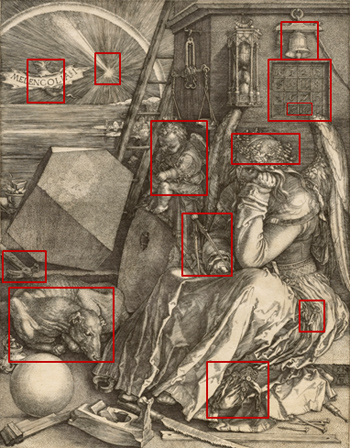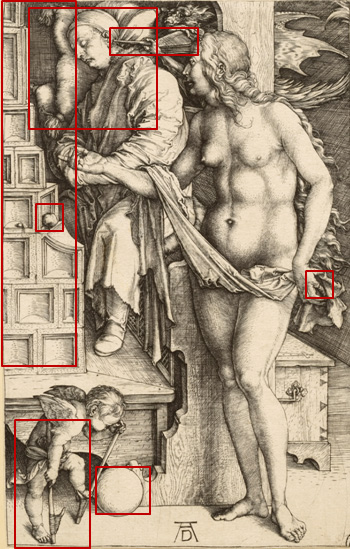
November 14, 2010–March 13, 2011

symbolism highlights
Cycle through each work to discover what its symbols would have meant to Dürer’s audience.








Adam and Eve
1504
Engraving
The four animals in lower right are representations of the four temperaments, or humors—phlegmatic, sanguine, melancholic, and choleric. The ancient theory, which existed into Dürer’s time, was that each human possessed all four humors. A person’s personality and ailments were determined by his or her predominant humor.
Bull: phlegmatic humor, calm, unemotional
Rabbit: sanguine humor, sensual, courageous, hopeful
Elk: melancholic humor, despondent, sleepless, irritable
Cat: choleric humor, cruel, easily angered, feminine
Mouse: male weakness
Mountain goat: lust and damnation
Serpent: evil
Parrot: salvation, the antidote to the serpent
Melencolia I
1514
Engraving
Figure of Melancholy: “Melancholic” is one of the four humors (see Adam and Eve). It was the least desirable humor because it was responsible for depression, apathy, and even insanity. The advantage of being melancholic, however, was that this humor tended to be associated with the most creative and intelligent individuals. It was believed that carpenters, mathematicians, artists, and grammarians all tended to be melancholic.
Hammer: Carpenter
Compass: Mathematician
Putto with notebook: Grammarian
Keys: Power
Purse: Wealth
Bell: Eternity
Bat: Darkness. Boiled bats were recommended by the ancients as a remedy for melancholy
Wreath: Made from a plant which was believed to be a cure for excessive melancholy
Comet: Sign of Saturn, the god affiliated with melancholy
Magic square: Orderliness of numbers, each line (horizontal, vertical, diagonal) adds up to 34. Thought to be a talisman to attract Jupiter (The god who could heal the effects of Saturn)
1514: The year of the death of Dürer’s mother. Also the date of this print
The Temptation of the Idler
(The Dream of the Doctor)
c. 1498
Engraving
Bellows: Stoking the fires of desire
Stove: Heated, incubated atmosphere
Warmed-over Apple: Sin of laziness
Orb: Fortune (see the orb that The Great Fortune stands on)
Cupid on Stilts: Precarious nature of love
Ring: Reference to the twelfth-century story of a young Roman boy who, at the prompting of the devil, placed his ring on the finger of a statue of Venus.
Knight, Death and the Devil
1513
Engraving
Fox tail: Lies
Dog: Truth and loyalty
Lizard: Impending danger
Oak leaves: The return from a successful hunt
Roots of trees: Precariousness of life
